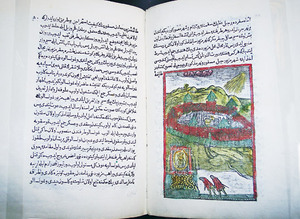The beginning of movable type book printing in the middle east
 Everyone knows that book printing in europe was "invented" or at least made commercially viable by Gutenberg around 1450. Yet I personally did not know or realize how difficult this concept of movable letters actually is in other scriptures around the world - take chinese for example - you need 7000+ letters in a box to make movable type work - everyone seeing a 26+ letter old school print shop can attest that this is not viable. Another scripture with similar problems is arabic. There are not soo many letters in the arabic alphabet but there are hundreds of different ways the calligraphers use these letters to make beautiful written pages and these are subconcious desicions about what ligatures to use under what circumstances. Today I stumbled over a text that explains the history of the arabic (ottoman turkish) foray into movable type printing and its inventor Ibrahim Müteferrika.
Everyone knows that book printing in europe was "invented" or at least made commercially viable by Gutenberg around 1450. Yet I personally did not know or realize how difficult this concept of movable letters actually is in other scriptures around the world - take chinese for example - you need 7000+ letters in a box to make movable type work - everyone seeing a 26+ letter old school print shop can attest that this is not viable. Another scripture with similar problems is arabic. There are not soo many letters in the arabic alphabet but there are hundreds of different ways the calligraphers use these letters to make beautiful written pages and these are subconcious desicions about what ligatures to use under what circumstances. Today I stumbled over a text that explains the history of the arabic (ottoman turkish) foray into movable type printing and its inventor Ibrahim Müteferrika.
To produce such a typeface, Müteferrika knew he had to analyze Arabic script. Calligraphers might learn to make the correctly shaped letter combinations by practice, without conscious application of tens of thousands of rules, but for machine reproduction of the script, deciphering those rules was exactly what was essential.
Using the limited technical resources of his time, Müteferrika succeeded in producing an Arabic typeface that gave primary importance to the nature of the Arabic script. Indeed, that had been part of his instructions from the Ottoman religious authorities, whose permission was essential for his project: He might mechanize existing calligraphic styles, he was told, but he was not to produce a bastardized, derivative form, and he was not to devise any new font designs. His font was the best produced to that time, says Milo.
The articles goes also into detail about the computerized version of this problem.
Read it all here.